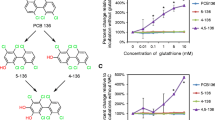Abstract
Microsomal oxidation of chrysene in rat liver occurs at various positions (1,2-; 3,4-; 5,6-). This has been verified by means of gas chromatography/mass spectrometry (GC/MS) and comparison with synthetic reference substances. After various rat pretreatments with inducers of the monooxygenase system the oxidation at the 3,4-position predominated in isolated microsomes. The formation of the ultimate carcinogen of chrysene—1, 2-dihydroxy-3,4-epoxy-1,2,3,4-tetrahydrochrysene — was not detectable in untreated rats. However, it was observed as 1,2,3-trihydroxy-1,2,3,4-tetrahydrochrysene-TMS-ether formed under workup and derivatisation conditions after pretreating the rats with phenobarbital, polychlorinated biphenyl, benzoflavone, or various polycyclic aromatic hydrocarbons. Polychlorinated biphenyls and benzoflavone were the most potent inducers for the formation of this metabolite.
Similar content being viewed by others
Abbreviations
- BjF:
-
Benzo(j)fluoranthene
- BNF:
-
5,6-benzoflavone
- GC:
-
gas-liquid chromatography
- HPLC:
-
high-pressure liquid chromatography
- MS:
-
mass spectrometry
- PAH:
-
polycyclic aromatic hydrocarbons
- PCB:
-
polychlorinated biphenyl
- TCBP:
-
3,3′,4,4′-tetrachlorobiphenyl
- TMS:
-
trimethylsilyl
References
Berenblum I, Schoental R (1949) The metabolism of chrysene: the isolation of 3-methoxychrysene by methylation of the phenolic metabolite of chrysene from rat faeces. Biochem J 44:604–606
McCann J, Choi E, Yamasaki E, Ames BN (1975) Detection of carcinogens as mutagens in the salmonella/microsome test: Assay of 300 chemicals. Proc Natl Acad Sci USA 72:5135–5139
van Duuren BL, Sivak A, Goldsmith BM, Katz C, Melchionne S (1970) Initiating activity of aromatic hydrocarbons in two-stage carcinogenesis. J Natl Cancer Inst 44:1167–1173
Grimmer G (1979) Prozesse, bei denen PAH entstehen. In: Umweltbundesamt (ed.) Berichte 1/79, Luftqualitätskriterien für ausgewählte polyzyklische aromatische Kohlenwasserstoffe. Erich Schmidt Verlag, Berlin, pp 54–58
Harper KH (1959) The intermediary metabolism of polycyclic hydrocarbons. Br J Cancer 13:718–731
Hecht SS, Bondinell WE, Hoffmann D (1974) Chrysene and methylchrysenes: Presence in tobacco smoke and carcinogenicity. J Natl Cancer Inst 53:1121–1133
Hoffmann D, Bondinell WE, Wynder EL (1974) Carcinogenicity of methylchrysenes. Science 183:215–216
IARC monography on the evaluation of carcinogenic risk of the chemical to man. Certain polycyclic aromatic hydrocarbons and heterocyclic compounds vol 3. IARC, Lyon, 1973 pp 161–165
Jacob J, Grimmer G, Schmoldt A (1979) Metabolitenprofile von polycyclischen aromatischen Kohlenwasserstoffen nach Vorbehandlung mit verschiedenen Induktoren mikrosomaler Monooxygenasen der Rattenleber. Hoppe-Seyler's Z Physiol Chem 360:1525–1534
Jacob J, Grimmer G, Schmoldt A (1981) The influence of polycyclic aromatic hydrocarbons as inducers of monooxygenases on the metabolite profile of benz(a)anthracene in rat liver microsomes. Cancer Lett 14:175–185
Jacob J, Schmoldt A, Grimmer G (1981) Glass-capillary-gas-chromatography/mass spectrometry data of mono- and polyhydroxylated benz(a)anthracene. Hoppe-Seyler's Z Physiol Chem 362:1021–1030
Kutt H, Fouts JR (1971) Diphenylhydantoin metabolism by rat liver microsomal preparations. J Pharmacol Exp Ther 176:11–26
Levin W, Wood AW, Chang RL, Yagi H, Mah HD, Jerina DM, Conney AH (1978) Evidence for bay region activation of chrysene 1,2-dihydrodiol to an ultimate carcinogen. Cancer Res 38:1831–1834
Lowry GL, Rosebrough NJ, Farr AL, Randall RJ (1951) Protein measurement with folin phenol reagent. J Biol Chem 193:265–275
Omura T, Sato R (1964) The carbon monoxide-binding pigment of rat liver microsomes. J Biol Chem 239:2370–2378
Scribner JO (1973) Tumor initiation by apparently noncarcinogenic polycyclic aromatic hydrocarbons. J Natl Cancer Inst 50:1717–1719
Sims P (1970) Qualitative and quantitative studies on the metabolism of a series of aromatic hydrocarbons by rat liver preparations. Biochem Pharmacol 19:795–818
Schmoldt A, Jacob J, Grimmer G (1981) Dose-dependent induction of rat liver microsomal aryl hydrocarbon monooxygenase by benzo(k)fluoranthene. Cancer Lett 13:249–257
Takahashi G, Kinoshita K, Hashimoto K, Yasuhira K (1979) Identification of benzo(a)pyrene metabolites by gas chromatography. Cancer Res 39:1814–1818
Vyas KP, Thakker DR, Yagi H, Levin W, Wood AW, Conney AH, Jerina DM (1981) Enantioselectivity in the metabolism, mutagenicity and tumorigenicity of the polycyclic aromatic hydrocarbon chrysene. Symposium on PAH Battelle (6th), Columbus/Ohio (USA)
Vyas KP, Levin W, Yagi H, Thakker DR, Ryan DE, Thomas PE, Conney AH, Jerina DM (1982) Stereoselective metabolism of the (+)- and (−)-enantiomers of trans-1,2-dihydroxy-1,2-dihydrochrysene to bay-region 1,2-diol-3,4-epoxide diastereomers by rat liver enzymes. Mol Pharmacol 22:182–189
Wood AW, Levin W, Ryan D, Thomas PE, Yagi H, Mah HD, Thakker DR, Jerina DM, Conney AH (1977) High mutagenicity of metabolically activated chrysene 1,2-dihydrodiol: Evidence for bay-region activation of chrysene. Biochem Biophys Res Commun 78:847–854
Wood AW, Levin W, Chang RL, Yagi H, Thakker DR, Lehr RE, Jerina DM, Conney AH (1979) Bay-region activation of carcinogenic polycyclic hydrocarbons. In: Jones PW, Leber P (eds) Polynuclear aromatic hydrocarbons. Ann Arbor Sci. Publ., Inc., Ann Arbor, MI, pp 531–551
Author information
Authors and Affiliations
Additional information
Assessment of environmental compounds by carcinogenspecific tests, part 1
Rights and permissions
About this article
Cite this article
Jacob, J., Schmoldt, A. & Grimmer, G. Formation of carcinogenic and inactive chrysene metabolites by rat liver microsomes of various monooxygenase activities. Arch Toxicol 51, 255–265 (1982). https://doi.org/10.1007/BF00348857
Received:
Issue Date:
DOI: https://doi.org/10.1007/BF00348857



